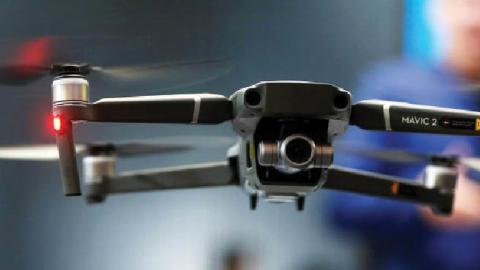The U.S. government at the federal, state, and local levels is using Chinese drones that the Chinese Communist Party is exploiting for espionage. That is the public conclusion of a branch of the Department of Homeland Security. Citing “security concerns,” other departments have all-but-explicitly publicly made the same claims, and some have begun to take steps to limit the purchase of Chinese drones.
Drones made in China and operated by Americans map U.S. infrastructure, agriculture, railroads, government buildings, power plants, disaster-relief operations, and the movements of law-enforcement officers. The data collected in those drone flights are believed to be sent back to China, where there is no divide between civil and military sectors. The Commerce Department’s listing on Friday of one major Chinese drone company on the U.S. entities list makes it difficult for U.S. companies to buy its products and underscores the growing sense of urgency to end their access to the United States. But it is time to go further. The U.S. government at all levels should immediately stop purchasing Chinese drones and end Chinese drone companies’ access to the U.S. commercial market.
The U.S. dependence on Chinese drones and the parts that go into drones is unsustainable. While there are U.S. companies waiting to meet demand if Chinese drones are excluded from the American market, there are still too few of them to meet the U.S. government’s needs, and some American drone companies still rely on cheap Chinese parts. This is one of the arguments against cutting off access to the Chinese drone market. But the risks to national security are too great to move slowly, and so in addition to cutting off access to the Chinese drone market, the U.S. should also expand existing Pentagon efforts to build an American and American-ally drone-manufacturing base that does not rely on Chinese-made parts. One can easily see how a national emergency or a conflict over the defense of democratic Taiwan could require ramping up the scale of production of drones. Depending on China for that should be out of the question.
Undersecretary of Defense for Acquisition and Sustainment Ellen Lord has been a champion for strengthening American sovereignty by developing an industrial base for critical technologies in the U.S. and in allied countries. At a recent Hudson Institute event with me, she touted the Pentagon’s Trusted Capital Marketplace, which would expand the options for secure drone manufacturers. This initiative should become a top national-security priority across the U.S. government and private sectors.
It’s important to counter companies such as Da Jiang Innovations Science and Technology Company (DJI), a Chinese-owned drone behemoth headquartered in Shenzhen, China. It dominates the American drone market. Its low cost has boxed out the American and ally market, giving it a nearly two-thirds share in the United States and Canada.
But DJI is more than just a market leader. Like other Chinese technology programs and companies such as Huawei, it also enables Chinese espionage and the Chinese surveillance state, specifically of the Xinjiang concentration camps.
An August 2017 Los Angeles office of the Immigration and Customs Enforcement bureau memorandum says: “The Chinese government directorates most likely receiving the data from DJI’s cloud are the offices responsible for defense, critical infrastructure, traffic controlling, and cyber offense . . .” Officials said they have “moderate confidence” that the DJI’s commercial drones and software are “providing U.S. critical infrastructure and law enforcement data to the Chinese government.” The flurry of other agency actions to slow the use of DJI drones suggests that officials now have more than “moderate” confidence this is occurring.
Other government agencies, such as the Department of Defense — with few exceptions for some applications — have stopped using Chinese drones. As of this fall, the Department of Justice has also banned DOJ funds from being used to purchase them. The largest agency that uses drones is the Department of Interior. The DOI has more than 800 drones, all of which are either made in China or have Chinese parts. They use these drones for search and rescue, fighting wildfires, and dealing with other natural disasters that may threaten life or property. In October, the Wall Street Journal reported that the DOI was grounding its entire fleet of aerial drones, citing a national-security risk from Chinese manufacturers.
We are aware of some of DJI’s ghastly cooperation inside of China. In 2017, just when U.S. officials were sounding alarm bells, DJI signed an agreement with the Xinjiang Autonomous Region Public Security Department (XARPSD) to deploy DJI drones for “stability maintenance” and “counter-terrorism.” This summer, drone footage went viral on American social-media platforms that showed a DJI drone monitoring Chinese paramilitary police escorting Uyghur Muslims — shackled and blindfolded — at a train station in Xinjiang, a city notorious for its “re-education camp” where the Chinese government engages in rape, abortions, forced sterilization, torture, and other means of religious and cultural genocide.
DJI was also eager to take advantage of the COVID-19 pandemic. This spring, it gave away free drones to 43 law-enforcement agencies in 22 U.S. states to outrageously enforce government social-distancing guidelines. That’s right: The Chinese company that enabled China’s government to monitor Chinese Muslims for compliance in concentration camps sought to enable U.S. governments to monitor Americans’ behavior for compliance during the COVID-19 pandemic.
Some members of Congress have been tracking the issue and trying to legislatively mandate that the U.S. government stop using Chinese drones and end its dependency on Chinese component parts for the drone market. Last year, Senator Rick Scott (R., Fla.) and Representative Mike Gallagher (R., Wis.) led a bipartisan coalition to introduce the American Security Drone Act. If enacted, it would, among other things, prohibit federal departments and agencies from buying any foreign commercial off-the-shelf drone or unmanned-aircraft system manufactured or assembled in countries identified as national-security threats.
For unclear reasons, and despite a bipartisan consensus that helped place drone-security provisions in the House version of the recent defense bill, the Senate stripped them out. The final bill sent to President Trump’s desk leaves the problem unaddressed. So DJI drones are still free to flood the U.S. market and send their images and data to the Chinese Communist Party. The bipartisan coalition focusing on this issue should expand and Congress should focus on the issue in the new year. In the meantime, with only a few weeks left of the Trump administration’s term, Trump should issue an executive order addressing the national security risks of Chinese drones, and in particular DJI drones. The sooner we can get Chinese drones off the market, the safer we’ll be.
Read in National Review

















